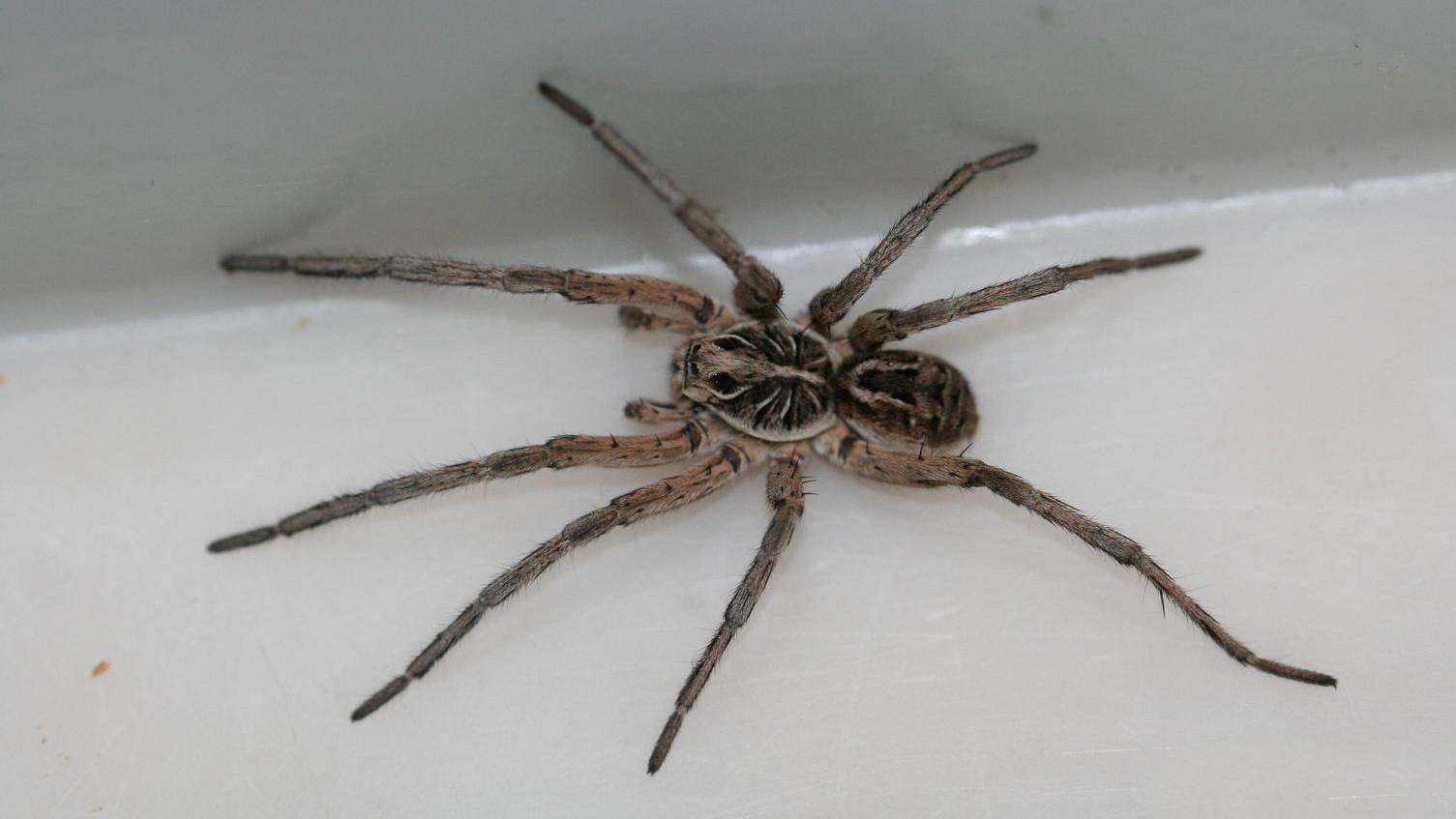Common spiders found in Maryland
Wolf spiders
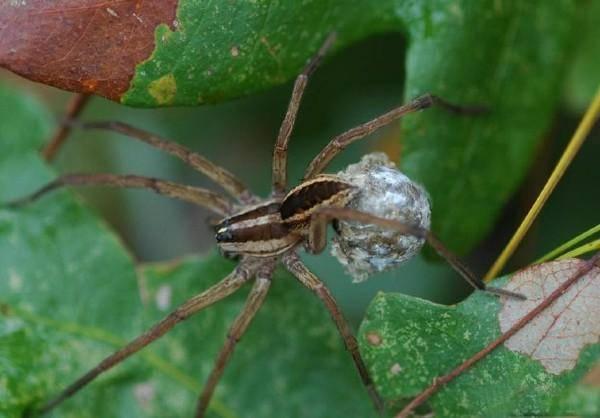
Wolf spider (Rabidosa rabida). Photo: Karan A. Rawlins, University of Georgia, Bugwood.org
-
Wolf spiders are active hunters (they can move fast) and do not construct webs. They have very good vision and hunt down prey day and night.
-
Their colors range from black and white to earth tones. The color may be uniform or patterned. The size varies from 1/4 inch to 1 1/2 inches in body length with a leg span of 3 inches.
-
Some wolf spiders can be fairly large and have a frightening appearance. They do not attack humans even if they run across one’s hand or foot, but if handled or confined, they can give a sharp bite. The bite is not dangerous.
-
Wolf spiders come indoors most frequently in the fall and are usually found in basements. Exclusion is the best way to keep them outdoors.
Jumping spiders

Jumping spider (Phidippus clarus). Photo: David Cappaert, Bugwood.org
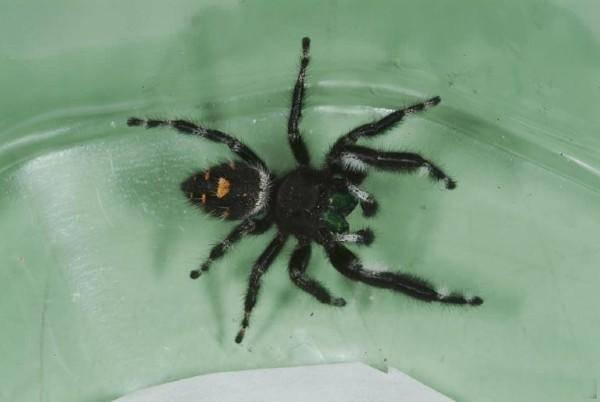
Daring jumping spider (Phidippus audax). Photo: Joseph Berger, Bugwood.org
-
Jumping spiders move in jumps or short, rapid runs.
-
They are frequently found around windows in search of prey such as flies.
-
Jumping spiders are often black, quite hairy, and as large as 1/3 inch long. They may be marked with red or white dots.
-
Jumping spiders generally do not appear in large numbers and can be removed individually.
Crab spider
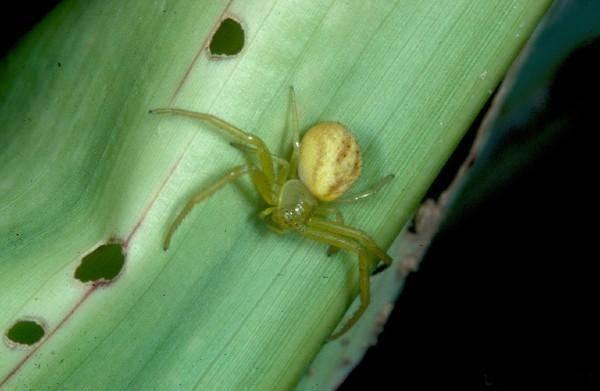
Crab spider. Photo: Frank Peairs, Colorado State University, Bugwood.org
-
Crab spiders are bright white, yellow or reddish with their legs projecting from their sides giving them the appearance of a crab.
-
They sit waiting on flowers and leaves ready to attack prey that comes along.
Black widow spider
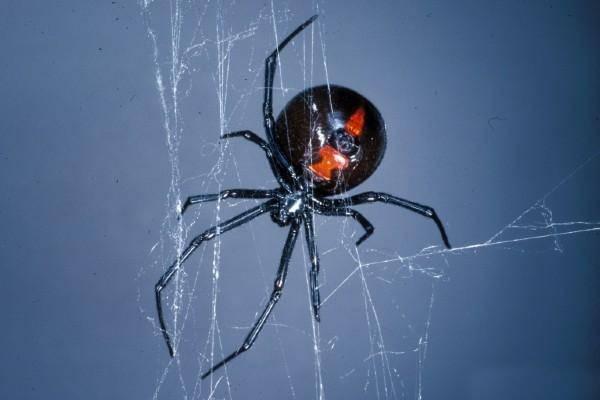
Black widow spider (Latrodectus mactans). Photo: Sturgis McKeever, Georgia Southern University, Bugwood.org
-
The black widow is common in Maryland but is not often found indoors. These spiders are most often found in basement window wells, beneath lawn benches or porches, and in garages, tool sheds, old lumber piles, rock piles, trash piles, and water meters. They may come inside in objects such as boxes, flowerpots, baskets, or other items stored outdoors for a period of time, where they have established their irregular webs.
-
The black widow female becomes mature in late summer and fall. She is confined to her web and is very clumsy when walking on a flat surface.
-
Her appearance is as follows: body about ½ inch long, jet black with a bright red hourglass shape on the belly. This red mark is easily seen because she hangs upside down in the web. Sometimes there may be small dull red marks on the top of the abdomen and at the tip. No other spider in Maryland looks like the black widow, nor is any as venomous. It is more dangerous to children than adults.
-
The black widow is not aggressive. It will, however, bite instinctively when touched or pressed, and for this reason, one should be very careful when working around areas where black widows may be established.
-
Take proper precautions: wear gloves and pay attention to where you are working. Black widow bites are sharp and painful. The victim should go to the doctor immediately for treatment. It is important to recognize this spider and describe the symptoms accurately and fully so the physician can diagnose the trouble correctly.
-
This spider can be cleaned out of an area simply by knocking the webs, spiders, and round, tan egg sacs down with a stick and crushing them under foot. Household insect sprays will kill the spiders when hit directly.
Cobweb spiders
-
Cobweb spiders are common household spiders that enter homes when they are small.
-
They build irregular webs in areas where insects fly or rest, usually in corners of rooms or windows. When they are active in the web, the web remains relatively inconspicuous, but when these spiders leave a web or die, the web becomes covered with dust and is easily seen.
-
Cleaning or dusting in areas frequented by these spiders is sufficient for control.
Yellow house spider
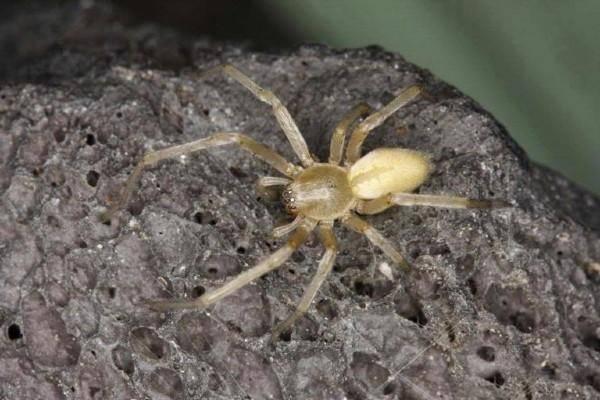
Yellow sac spider (Cheiracanthium inclusum). Photo: Joseph Berger, Bugwood.org
-
Yellow house spiders are small, about ¼ inch long, and move rapidly.
-
They may be found in all rooms of a house. The spiders enter homes in early fall and are active for several months weaving small white webs in confined spaces where they spend the winter.
-
In the spring, they usually emerge from their white web cells and find their way outside.
Orb weavers - garden spiders
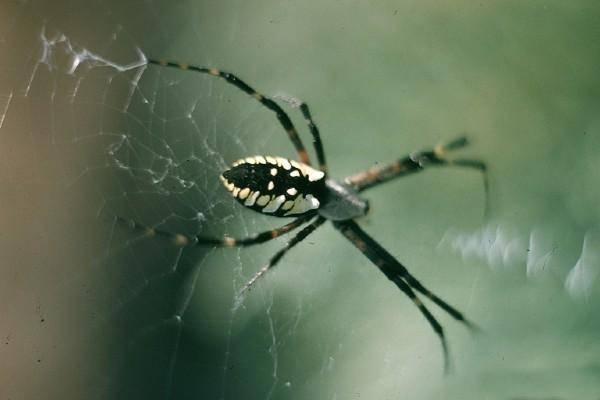
Yellow garden spider. Photo: Edward L. Manigault, Clemson University Donated Collection, Bugwood.org
-
Garden spiders such as the black and yellow Argiope aurantia are orb-weaving spiders.
-
Orb weavers produce a neat, flat, classic spider web. The web is used to capture prey as these spiders have poor vision.
-
There are more than 2,500 species of orb weavers in the United States, but one of the most recognizable is the black and yellow Argiope aurantia. They are most often seen in late summer and fall.
-
They are large and marked with black and yellow or orange. The web may be up to 2 feet in diameter and stretched across a path, between shrubs or across tall weeds. They are great at catching all kinds of insects including stink bugs that happen to stumble into their webs and unfortunately the occasional butterfly.
Pennsylvania grass spider - funnel weaver
Spiders in the Mist: Funnel Weaving Spider, Pennsylvania Grass Spider, 'Agelenopsis pennsylvanica' - Dr. Mike Raupp, Professor of Entomology, Bug of the Week
Brown recluse (Loxosceles reclusa) - not commonly found in Maryland
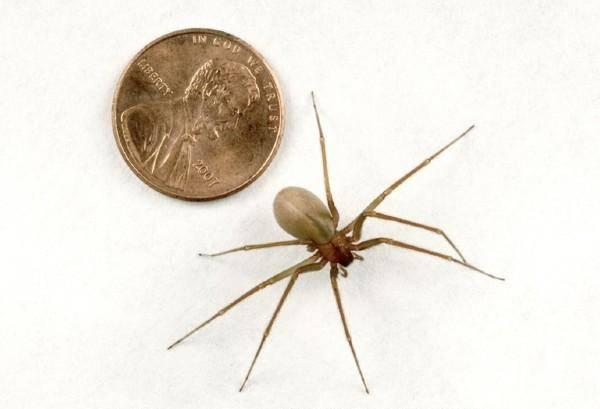
Brown recluse spider (Loxosceles reclusa). Photo: Ed Freytag, City of New Orleans, Bugwood.org

Range of recluse spiders in the U.S. Map: Rick Vetter, spiders.ucr.edu
-
This spider is not found in Maryland. They are not native here and cannot survive the climate. On rare occasions, they can be brought into the state in moving or shipping boxes.
-
This is a venomous spider principally found in the lower central Midwest and the south central United States.
-
Bites occur when the spider is inadvertently pressed or touched. The bite of a brown recluse spider causes a wound, which takes 6 weeks or more to heal. In rare instances, it has caused death to sensitive individuals.
-
The brown recluse makes no conspicuous web but moves about rapidly.
-
This spider is very shy and reclusive. Indoors, it is typically found in storage areas, closets, and infrequently used clothes and beds, and less utilized areas of a home.
Appearance
-
The appearance of the brown recluse spider is unique.
-
Its body is about ¼ inch long, the legs covering the area of a coin the size of a quarter.
-
The front half of the spider is marked with a violin-shaped design and the rear half of the abdomen is unmarked and tan or brown.
-
All other brown colored spiders this size have either no design at all or have stripes or spots on the front half – never a violin-shaped design. Abdomens of other spiders are rarely unmarked but generally exhibit spots, triangles or bands.
Spiders indoors
Many different spiders may enter homes, including jumping spiders, yellow house spiders, wolf spiders, and black widow spiders (rarely). All spiders are predators and feed on insects or related animals. Some species can live in homes feeding on other spiders, flies, ants, and cockroaches.
Management indoors
Spiders may wander indoors through or around windows, doors, and cracks. They will sometimes move into homes in the fall seeking shelter. Caulk cracks and tighten up around doors and windows, especially those at ground level. Some spiders live in webs and seldom leave them, while others are active hunters. Generally, if you control the spiders' prey, you will control the spiders.
The removal of spider breeding places outside the home can help contribute greatly to spider management. Trash, piles of lumber, weeds, leaves, flower pots, and any other objects piled or stacked next to the house provide areas where spiders can live and breed undisturbed.
